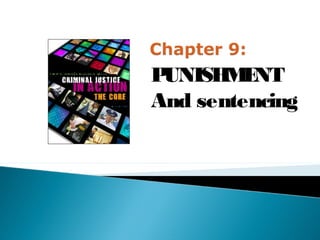
Chapter9
- 1. PUNISH E M NT And sentencing
- 2. List and contrast the four basic philosophical reasons for sentencing criminals.
- 3. Retribution – the philosophy that those who commit criminal acts should be punished based on the severity of the crime Incapacitation – a strategy for preventing crime be detaining wrongdoers in prison Deterrence – preventing crime through the threat of punishment Rehabilitation – providing wrongdoers the resources they need to eliminate criminality from their behavioral pattern
- 4. Contrast indeterminate with determinate sentencing.
- 5. Indeterminate Determinate Sentencing – a practice Sentencing – a practice in which the sentence in which the period of of a convicted person incarceration for identifies a minimum specific crimes is fixed and maximum time to by a sentencing be served, rather than authority and cannot be a specific time to be reduced by judges or served. other corrections officials.
- 6. Explain why there is a difference between a sentence imposed by a judge and the actual sentence served by the prisoner.
- 7. “Good time” - reduction in time served by prisoners based on good behavior, conformity to rules, and other positive actions. Truth-in-sentencing law – a legislative attempt to ensure that convicts will serve approximately the terms to which they were initially sentenced. Judicial Sentencing Authority Administrative Sentencing Authority
- 9. List the six forms of punishment.
- 10. Forms of Punishment: Capital punishment Imprisonment Probation Fines Restitution and community service Restorative justice
- 11. State who has input into the sentencing decision and list the factors that determine a sentence.
- 12. The Sentencing Process: The presentence investigative report. Recommendations from the prosecutor and defense attorney. The role of the jury in capital cases.
- 13. Factors of sentencing: Seriousness of the crime Aggravating and mitigating circumstances Judicial philosophy
- 15. Explain some of the reasons why sentencing reform has occurred.
- 16. Sentencing Disparity: Sentencing Those who commit Discrimination: similar crimes should When the sentence is receive similar influence by race, punishments. gender, economic status, or some other factor not related to the crime.
- 17. Three ways disparity occurs: Offenders receive similar sentences for different crimes of unequal seriousness Offenders receive different sentences for unequal crimes Mitigating or aggravating circumstances have a disproportionate effect on sentencing
- 18. Sentencing Discrimination: The “Punishment Penalty” ◦ Rates of imprisonment rise significantly for those who are young, minority, and unemployed. Women and Sentencing ◦ Women convicted of crimes are less likely to go to prison than their male counterparts.
- 19. Sentencing Guidelines ◦ State Sentencing Guidelines ◦ Federal Sentencing Guidelines ◦ Judicial Departures Mandatory Sentencing Guidelines ◦ Habitual Offender Laws ◦ “Three Strikes” in Court
- 20. Methods of Execution The Death Penalty and the Supreme Court ◦ Weems v. United States (1910) ◦ Furman v. Georgia (1972) Reforming the Death Penalty
- 22. Identify the two stages that make up the bifurcated process of death penalty sentencing.
- 24. The Bifurcated Process: Furman v. Georgia (1972) Court Approval The Jury’s Role Mitigating Circumstances ◦ Insanity ◦ Mentally Handicapped ◦ Age
- 25. Describe the main issues of the death penalty debate.
- 27. Questions: ◦ Do you believe lethal injection should be considered cruel and unusual punishment? ◦ Do you believe that methods that were one day considered acceptable (such as the firing squad) are cruel and unusual?
- 28. Deterrence – does it deter crime? Fallibility – does the system make mistakes? Arbitrariness – is it arbitrary?
- 30. The Immediate Future of the Death Penalty ◦ Reasons for the Decline in Executions ◦ Continued Support for the Death Penalty
- 32. Questions: ◦ Should an individual be executed if there is DNA evidence that could be tested, but has not been tested? ◦ Should an individual be eligible for capital punishment if there is the absence of DNA evidence?
